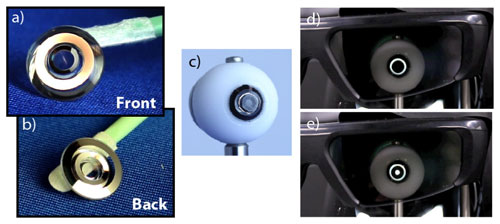/ News

Telescopic contact lens with switchable magnification to help AMD patients
Age-related macular degeneration (AMD) is the leading cause of blindness among older adults in the western world. Unfortunately, conventional optical aids provide little help for a retina which has lost the acuity of its central area. Now a team of multinational researchers led by University of California, San Diego (UCSD) Professor Joseph Ford has created a telescopic contact lens that can switch between normal and magnified vision to offer AMD patients a relatively unobtrusive way to enhance their vision.
When I was younger, I had a friend named Earl who suffered from AMD, a condition which slowly destroys the macula, the high-resolution central region of the eye's cornea. Earl had three outstanding characteristics, beyond being a thoroughly nice and intelligent person. He was an avid amateur astronomer (observing mostly deep-sky objects, which are naturally fuzzy), collected '57 Chevys, and terrified everyone by using a tiny 8 x 25 monocular while driving cars and trucks with manual transmissions, even at night. Fortunately, I'm not aware that Earl ever had an auto accident.
Earl had put to use the basic principle behind the new telescopic contact lens developed at UCSD. If you magnify the image, your inability to see small detail is less troubling. Over the years, people have used small binocular telescopes similar in appearance to dentist's magnifiers, very thick (4.4 mm) contact lenses containing small Galilean telescopes, and other contrivances that have not been well accepted because of their appearance, limited field-of-view, and vestibular problems (balance and dizziness) caused by the mismatched efforts of the eye to stabilize the image.
More recently, implantable telescopes have appeared that perform better than the previous makeshift devices. However, these require surgical implantation along with removal of the natural lens, and seriously limit the amount of light available for the magnified vision. Such implants also tend to be rather expensive, coming in at well above US$25,000 per eye when all is said and done. As a result, cases which do not require such invasive procedures have largely remained untreated.

The playing field is now in the process of changing, and the thin (1.17 mm) telescopic contact lens shown above that is being developed by the UCSD team is part of that movement. “For a visual aid to be accepted it needs to be highly convenient and unobtrusive,” says co-author Eric Tremblay of the École Polytechnique Fédérale de Lausanne (EPFL) in Switzerland. A contact lens is an “attractive compromise” between the head-mounted telescopes and surgically implanted micro-telescopes, according to Tremblay.
The design of the switching magnification contact lens is really very clever. As shown in the following image, the annular optical path of the 2.8X telescopic lens is folded back on itself four times before being relayed into the eye. An unobstructed central portion about 2.2 mm in diameter provides the light for 1X vision. The complex and precise shape of the contact lens is made by diamond turning, a procedure that yields optical surfaces ready for use.

Switching between the two modes is accomplished by using special glasses to change the polarization of the incoming light. These glasses, which are worn with the contact lens, have a linear polarizer backed by a liquid crystal optical element that rotates the polarization when a voltage is applied.
When the light polarization emerging from the liquid crystal element is aligned with that over the central aperture, only light hitting that central aperture enters the contact lens, with the result being an unmagnified view. If the control voltage is changed so that an additional 90 degrees of polarization shift occurs, then light will only enter the contact through the magnified annulus, giving a 2.8X magnified view. The switch is very rapid, and inconspicuous to one's companions, unless they are wearing polarized sunglasses.

The researchers say their proof-of-concept system still needs to be refined before it can be used by consumers. Professor Ford's team is already planning an improved contact having the structure shown above. The new contact will use two materials to obtain an achromatic image, rather than the diffractive optical surface of the original design, which requires a high degree of precision in manufacture.
Unlike the robust PMMA material used for the proof-of-concept system, which is gas-impermeable so can only be worn for short periods of time, the new materials will be gas permeable, and the overall permeability will be assisted through the use of air channels. Conformal polarizers will also simplify the assembly process, the new contacts being in only one piece.
“In the future, it will hopefully be possible to go after the core of the problem with effective treatments or retinal prosthetics,” says Tremblay. “The ideal is really for magnifiers to become unnecessary. Until we get there, however, contact lenses may provide a way to make AMD a little less debilitating.”
Sources: OSA and Optics Express
Source: http://www.gizmag.com/telescopic-contact-lens-provides--normal-and-magnified-vision/28087/
/ About us
Founded by Russian entrepreneur Dmitry Itskov in February 2011 with the participation of leading Russian specialists in the field of neural interfaces, robotics, artificial organs and systems.
The main goals of the 2045 Initiative: the creation and realization of a new strategy for the development of humanity which meets global civilization challenges; the creation of optimale conditions promoting the spiritual enlightenment of humanity; and the realization of a new futuristic reality based on 5 principles: high spirituality, high culture, high ethics, high science and high technologies.
The main science mega-project of the 2045 Initiative aims to create technologies enabling the transfer of a individual’s personality to a more advanced non-biological carrier, and extending life, including to the point of immortality. We devote particular attention to enabling the fullest possible dialogue between the world’s major spiritual traditions, science and society.
A large-scale transformation of humanity, comparable to some of the major spiritual and sci-tech revolutions in history, will require a new strategy. We believe this to be necessary to overcome existing crises, which threaten our planetary habitat and the continued existence of humanity as a species. With the 2045 Initiative, we hope to realize a new strategy for humanity's development, and in so doing, create a more productive, fulfilling, and satisfying future.
The "2045" team is working towards creating an international research center where leading scientists will be engaged in research and development in the fields of anthropomorphic robotics, living systems modeling and brain and consciousness modeling with the goal of transferring one’s individual consciousness to an artificial carrier and achieving cybernetic immortality.
An annual congress "The Global Future 2045" is organized by the Initiative to give platform for discussing mankind's evolutionary strategy based on technologies of cybernetic immortality as well as the possible impact of such technologies on global society, politics and economies of the future.
Future prospects of "2045" Initiative for society
2015-2020
The emergence and widespread use of affordable android "avatars" controlled by a "brain-computer" interface. Coupled with related technologies “avatars’ will give people a number of new features: ability to work in dangerous environments, perform rescue operations, travel in extreme situations etc.
Avatar components will be used in medicine for the rehabilitation of fully or partially disabled patients giving them prosthetic limbs or recover lost senses.
2020-2025
Creation of an autonomous life-support system for the human brain linked to a robot, ‘avatar’, will save people whose body is completely worn out or irreversibly damaged. Any patient with an intact brain will be able to return to a fully functioning bodily life. Such technologies will greatly enlarge the possibility of hybrid bio-electronic devices, thus creating a new IT revolution and will make all kinds of superimpositions of electronic and biological systems possible.
2030-2035
Creation of a computer model of the brain and human consciousness with the subsequent development of means to transfer individual consciousness onto an artificial carrier. This development will profoundly change the world, it will not only give everyone the possibility of cybernetic immortality but will also create a friendly artificial intelligence, expand human capabilities and provide opportunities for ordinary people to restore or modify their own brain multiple times. The final result at this stage can be a real revolution in the understanding of human nature that will completely change the human and technical prospects for humanity.
2045
This is the time when substance-independent minds will receive new bodies with capacities far exceeding those of ordinary humans. A new era for humanity will arrive! Changes will occur in all spheres of human activity – energy generation, transportation, politics, medicine, psychology, sciences, and so on.
Today it is hard to imagine a future when bodies consisting of nanorobots will become affordable and capable of taking any form. It is also hard to imagine body holograms featuring controlled matter. One thing is clear however: humanity, for the first time in its history, will make a fully managed evolutionary transition and eventually become a new species. Moreover, prerequisites for a large-scale expansion into outer space will be created as well.
Key elements of the project in the future
• International social movement
• social network immortal.me
• charitable foundation "Global Future 2045" (Foundation 2045)
• scientific research centre "Immortality"
• business incubator
• University of "Immortality"
• annual award for contribution to the realization of the project of "Immortality”.



 LinkedIn
LinkedIn
 LiveJournal
LiveJournal
 Google
Google
 Twitter
Twitter
 Facebook
Facebook
 Я.ру
Я.ру
 ВКонтакте
ВКонтакте
 Mail.ru
Mail.ru